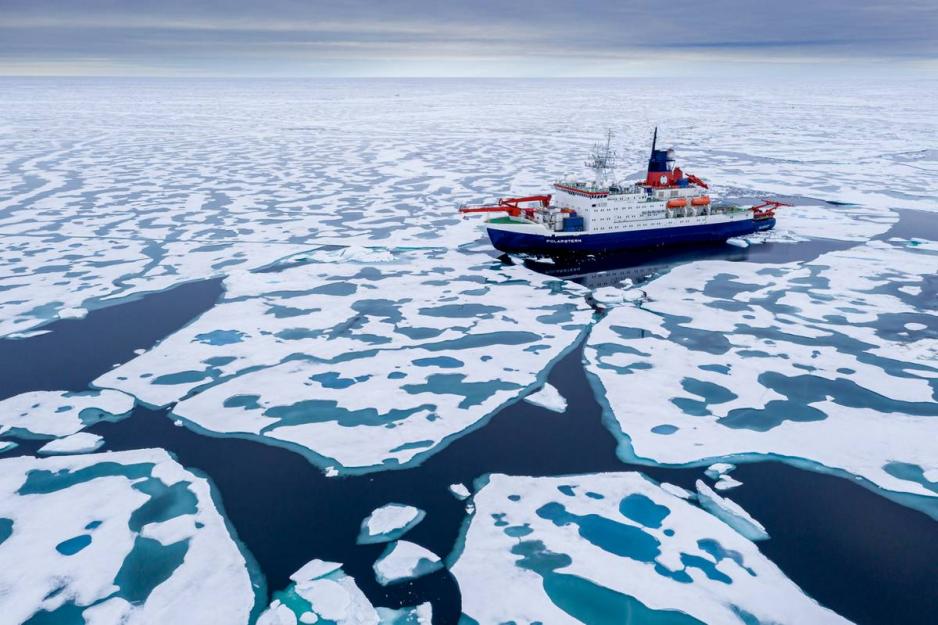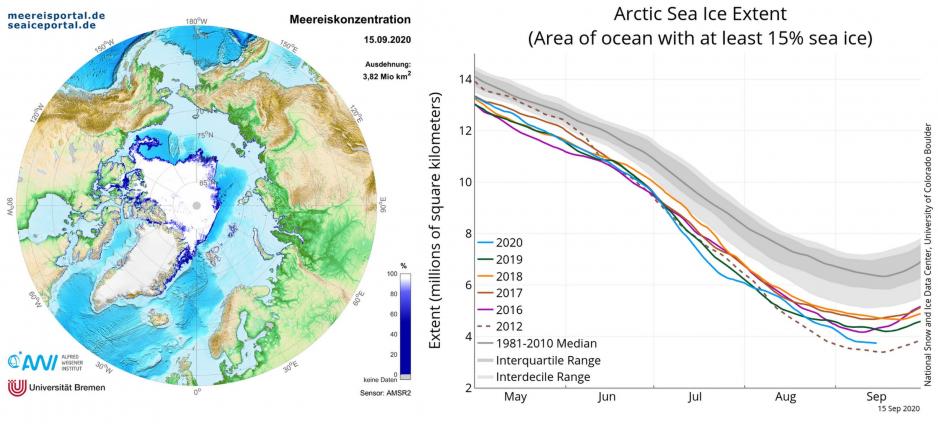Arctic Sea Ice Shrinks to Second-Lowest Extent Amid Record High Temperatures

Research icebreaker Polarstern passing through broken ice en route to the North Pole in August 2020. (Source: Courtesy AWI/Steffen Graupner)
Following the warmest summer on record in the Arctic, just 3.74 million square kilometers of Arctic sea ice remain. This is the second-lowest ice extent since satellite observations began in 1979 and only the second time that sea ice shrank below 4 million square kilometers.
Arctic sea ice reached its annual minimum on September 15th, according to climate scientists at the U.S.’ National Snow and Ice Data Center (NSIDC) and Germany’s Alfred Wegener Institute (AWI). With around 3.75 million km2, this year only trails the record-low of 3.4 million km2 set in 2012.
This summer saw the highest average temperature in the lower atmosphere in the Arctic and significantly above average water temperatures in parts of the Arctic Ocean resulting in widespread melting. Rapid sea ice loss during summer months to near record levels no longer comes as a surprise to climate scientists.
The 14 lowest ice extents in the Arctic have all occurred in the last 14 years. While sea ice covered an average of 6.7 million km2 at the end of summer between 1979-2000, it now routinely covers less than 4.5 million km2.

Map showing Arctic ice coverage on September 15 and graphic showing 2020 ice extent in comparison to previous years. (Source: Courtesy of AWI and NSIDC)
Recording-breaking heat over Siberia
Researchers at AWI identified two main reasons for the above average sea ice melt this summer. In early spring persistent offshore winds across Siberia pushed weakened first year ice northward resulting in thin ice cover along Russia’s coastline that broke up in March, months earlier than is traditionally the case.
This development also enabled unseasonably early shipping traffic along Russia’s Northern Sea Route where the first vessels traveled along the route at the end of May instead of mid-July as in previous years.
In May and June extremely high air temperatures– as much as 6 degrees Celsius above the long-term average, and above average sea temperatures further accelerated the sea ice melt.
“This heat first melted the thin sea ice in the Laptev Sea; then it accelerated the ice retreat in the East Siberian Sea. As a result, by June the Russian Arctic contained roughly one million square kilometers less sea ice than in the past seven years,” explains Prof Christian Haas, Head of the Sea Ice Physics Section at AWI in Bremerhaven.
Subsequent to the Siberian heat waves, a large high pressure system controlled the region’s weather for much of the summer resulting in sunny skies and mild temperatures, further accelerating sea ice loss.
Zachary Labe, Postdoctoral Researcher for Atmospheric Sciences at the Colorado State University concurs and offers this narrative for this year’s Arctic summer.
“While we didn't surpass the record low extent of 2012, there were plenty of other extreme weather and climate events in the Arctic. Persistent warmth over Northern Siberia contributed to the earliest retreat of sea ice on record along the coast of Eurasia.”
Warm water melts ice from below
Extreme temperatures and weather, however, were not just limited to the Russian side of the Arctic. The center of the Arctic Ocean also saw a prolonged heat wave and a strong storm in the Canadian Arctic broke up many of the ice floes accelerating melt.
“We believe that due to the stable high-pressure cell over the Central Arctic in July and August there were far more cloudless days. Therefore, as a result, the solar radiation which is normally buffered by clouds was an additional factor in this year’s melting,” explains AWI climatologist Dr Monica Ionita.
Pressure on sea ice came not only from atmospheric conditions but also from high surface water temperatures. In Norway’s and Russia’s Barents Sea as well as in the Chukchi Sea between Russia and Alaska water temperature was as much as 4.5 degrees Celsius above the long-term average.
The causes for the above-average warming of the Arctic compared to other parts of the world remains a subject of scientific studies. Earlier this year new research also suggested that ozone-depleting gases could be responsible for up to half of the warming in the Arctic.
Ice-free North Pole
The ice melt also extended into the Central Arctic Ocean, which saw widespread areas of open water.
“Sea ice in the Central Arctic, above 80°N latitude, is also a particularly striking statistic - the extent of sea ice in the highest latitudes of the Arctic has dropped to the lowest ever recorded,” explains Labe.

Graph showing record-low ice extent in the Central Arctic Ocean. (Source: Courtesy Zachary Labe)
The increasing melt and the thinness of the ice was also observed by the scientists aboard the German research icebreaker Polarstern, which traveled to the North Pole as part of the MOSAiC expedition. The researchers encountered open waters stretching nearly to the Pole, according to Expedition Leader Prof Markus Rex.
Persistent above average sea temperatures may also impede the formation of sea ice and delay the re-freezing of the Arctic Ocean this fall.
“All of this suggests that climate change continues to significantly impact sea ice in the northernmost portions of our planet. Without reductions in greenhouse gas emissions, climate change will continue to alter the Arctic climate system through additional losses of ice, thawing permafrost, and warming temperatures,” concludes Labe.
And ongoing research suggests that the impacts of this new “ice-free” Arctic on global climate systems could potentially already be felt outside the region by affecting weather and climate in lower latitudes.



